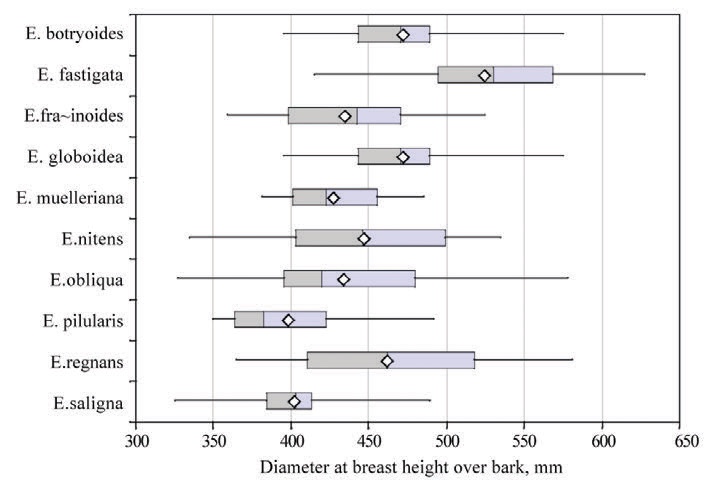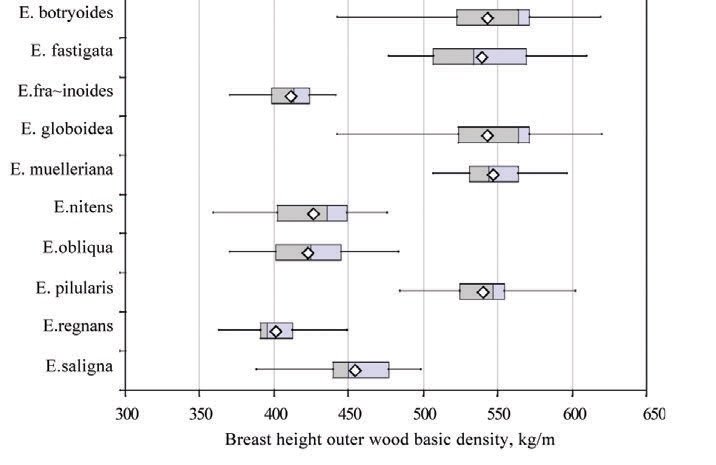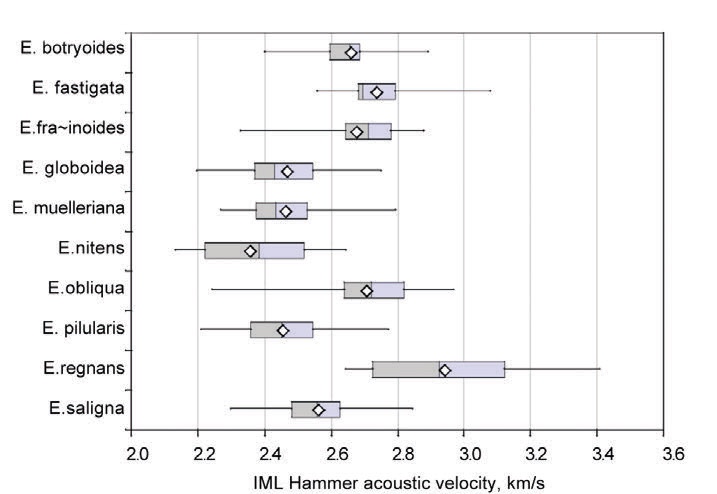Growth and wood from eucalypts in Rotehu forest
Trevor Jones, New Zealand Tree Grower August 2010.
The adaptation of different eucalypt species to climatic conditions and the type of wood produced varies widely. The 1980 species demonstration planting at Rotoehu forest, in the Bay of Plenty, provided the opportunity to show this by comparing the growth and wood properties of ten eucalypt species from one site at age 25 years. A total of 15 trees of each species from the block plantings were selected with good form and growth.
Tree growth
The diameter growth of the trees reflected the species adaption to the climatic conditions and the untended nature of the block plantings. Eucalyptus fastigata showed the fastest diameter growth and was well adapted to this coastal North Island site. The climatic conditions of −
- 13.5°C average annual temperature,
- 18.3°C average temperature of the hottest month
- 8.3 °C average temperature of the coldest month,
- 2.6°C average minimum temperature of the coldest month
- 1,751 mm average annual rainfall
− were well within the climatic requirements for this species.
The slower growth of E. muelleriana was an indication of the marginal climatic conditions at Rotoehu forest, with the average annual temperature at the low end of the natural range for this species in Australia. The poorer survival and slower growth of E. pilularis showed this species was off-site at Rotoehu forest, with the average annual temperature, and the average minimum temperature of the coldest month lower than the climatic requirements for the species.



Comparison with other eucalypt trials at Rotoehu showed similar differences in diameter growth for E. fastigata, E. fraxinoides, E. obliqua and E. regnans, but slower growth for E. nitens and faster growth for E. saligna.
The control of the Paropsis charybdis beetle on E. nitens, following the release of a parasitoid wasp in 1987, may explain the better growth of the E. nitens trees in this trial. Other trials showed much slower growth of E. nitens compared with E. fastigata and E. regnans, before control of Paropsis. Leaf loss on E.saligna caused by the pathogen Phytophthora captiosa, and more recently by the insects Ophelimus eucalypti and Cardiaspina fiscella, may explain the slower growth compared with earlier trials of this species.
The initial stocking of the blocks in this trial was 1,650 stems per hectare, and in the absence of thinning, E. fastigata showed a high stocking retention of 1,433 stems per hectare.
Wood density
The wood density of eucalypts is important in determining the bending strength, stiffness and surface hardness of the wood. The breast height outer wood increment cores showed large species differences in wood density with E. botryoides, E. fastigata, E. globoidea, E. muelleriana and E. pilularis having higher density, E. saligna intermediate, with E. fraxinoides, E. nitens, E. obliqua and E. regnans having lower wood density.
Comparison with other sites showed the wood density was high for E. fastigata and low for E. saligna in this trial. The E. fastigata trees were grown from a seedlot collected from the Oakura stand in Taranaki, which has high wood density. This seedlot has shown higher wood density than other seedlots from New Zealand and Australian sources in a trial in Kaingaroa forest. The E. saligna in this trial had lower wood density than another similar aged stand in Rotoehu forest. The wood density of E. pilularis at Rotoehu forest was similar to re-growth of a similar age in New South Wales.
Acoustic velocity
The acoustic velocity provides a measure of the cellulose microfibril angle and grain angle of the wood. The time-of- flight measurements of acoustic velocity on the standing trees, using the IML Hammer, showed large species differences in acoustic velocity in the outer wood of the tree stems. This may reflect species differences in the stiffness and the grain angle of the wood.
The ash eucalypts E. fastigata, E. fraxinoides, E. obliqua and E. regnans have straight grain and higher acoustic velocity. The eastern blue gums E. botryoides and E. saligna have straight or slightly interlocked grain and intermediate acoustic velocity, and E. globoidea, E. muelleriana, E. nitens and E. pilularis have interlocked grain and lower acoustic velocity.
The results are from the work of Ruth McConnochie, Tony Shelbourne, Charlie Low and Ian Nicholas, and are made available by Future Forests Research Ltd. Trevor Jones is a scientist at Scion.

 Farm Forestry New Zealand
Farm Forestry New Zealand

